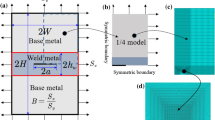Abstract
The change in near-tip stress field in Small Scale Yielding (SSY) for cracks located at an interface between two materials with different plastic work hardening is investigated. The difference in hardening is termed hardening mismatch, and is quantified through the parameter Δn, which is the difference in hardening exponent between the two materials. For cracks in elastic-ideally plastic materials the stress level in front of the crack tip is mainly controlled by the angular extent of the part where the slip lines are curved, often referred to as a centered fan like slip line sector. It is shown that for an elastic-ideally plastic material coupled to a material with non-zero hardening, an increase in stress is observed due to an extension of this centered fan like slip line sector. The angular extension of the centered fan like sector is dependent on the radial distance from the crack tip. Further, the change in stress depends strongly on hardening mismatch, increasing as Δn increases. For the situation with coupling between two non-zero hardening materials it is shown that the full field stress solution develops in a self-similar manner, but differs from the homogeneous case due to a coupling between the radial and angular stress field dependence. The amplitude of the change in stress field is to a rather good approximation only controlled by the hardening mismatch, Δn, and is more or less independent of the absolute values of hardening exponent of the two materials.
Similar content being viewed by others
References
Beremin, F.M. (1983). A local criterion for cleavage fracture of a nuclear pressure vessel steel. Met. Trans. A 14A, 2277–2287.
Curry, D.A. (1980). Cleavage micromechanisms of crack extension in steels. Metal Science, pp. 319–326.
Drugan, W.J., Rice, J.R., and Sham, T.-L. (1982). Asymptotic analysis of growing plane strain tensile cracks in elastic-ideally plastic solids. Journal of the Mechanics and Physics of Solids 30, 447–473.
Du, Z.Z. and Hancock, J.W. (1991). The effect of non-singular stresses on crack-tip constraint. Journal of the Mechanics and Physics of Solids 39, 555–567.
Ganti, S. and Parks, D.M. (1997). Elastic-plastic fracture mechanics of strength-mismatched interface cracks, Recent Advances in Fracture. (Edited by Mahidhara, R.K., Geltmacher, A.B., Matic P., and Sadananda, K.) The Minerals, Metals & Materials Society, pp. 13–25.
Ganti, S., Parks, D.M., and McClintock, F.A. (1997). Analysis of strength mis-matched interface cracks in SSY. Mis-Matching of Interfaces and Welds (Edited by Schwalbe K.-H. and Kocak, M.) GKSS Research Center Publications, Geesthacht, pp. 3–16.
Hutchinson, J.W. (1968). Singular behaviour at the end of a tensile crack in a hardening material. Journal of the Mechanics and Physics of Solids 16, 13–31.
Larsson, S.G. and Carlsson, A.J. (1973). Influence of non-singular stress terms and specimen geometry on smallscale yielding. Journal of the Mechanics and Physics of Solids 21, 263–277.
O'Dowd, N.P. and Shih, C.F. (1991). Family of crack-tip fields characterized by a triaxiality parameter-I. Structure of fields. Journal of the Mechanics and Physics of Solids 39, 989–1015.
O'Dowd, N.P. and Shih, C.F. (1992). Family of crack-tip fields characterized by a triaxiality parameter-II. Fracture application. Journal of the Mechanics and Physics of Solids 40, 939–963.
Ranestad, Ø, Zhang, Z.L., and Thaulow, C. (1997). Two-parameter (J-M) description of crack tip stress-fields for an idealized weldment in small scale yielding. International Journal of Fracture 88, 315–333.
Rice, J.R. (1968). A path independent integral and the approximate analysis of strain concentration by notches and cracks. Journal of Applied Mechanics 35, 379–386.
Rice, J.R. (1974). Limitations to the small scale yielding approximation for crack tip plasticity. Journal of the Mechanics and Physics of Solids 22, 17–26.
Rice, J.R. and Rosengren, G.F. (1968). Plane strain deformation near a crack tip in power-law hardening material. Journal of the Mechanics and Physics of Solids 16, 1–12.
Rice, J.R. (1982). Elastic-plastic crack growth. In: Mechanics of Solids – The Rodney Hill 60th Anniversary Volume, (Edited by Hopkins, H.G. and Sewell, M.H.) Pergamon Press, Oxford, pp. 539–562.
Rosenfield, A.R. and Majumdar, B.S. (1987). Micromechanisms and toughness for cleavage fracture of steel. Nuclear Engineering and Design 105, 51–57.
Sham, T.-L., Li, J., and Hancock, J.W. (1999). A family of plane strain crack tip stress fields for interface cracks in strength-mismatched elastic-perfectly plastic solids. Journal of the Mechanics and Physics of Solids 47, 1963–2010.
Shih, C.F. and Asaro, R.J. (1988). Elastic-plastic analysis of cracks on bimaterial interfaces: Part I – Small scale yielding. Journal of Applied Mechanics 55, 299–316.
Shih, C.F. and Asaro, R.J. (1989). Elastic-plastic analysis of cracks on bimaterial interfaces: Part II – Structure of small scale yielding fields. Journal of Applied Mechanics 56, 763–779.
Shih, C.F., Asaro, R.J., and O'Dowd, N.P. (1991). Elastic-plastic analysis of cracks on bimaterial interfaces: Part III – Large-scale yielding. Journal of Applied Mechanics 58, 450–463.
Thaulow, C., Zhang, Z.L., Ranestad, Ø., and Hauge, M. (2000). J-Q-M approach for failure assessment of fusion line cracks: Two materials and three material models. Fatigue and Fracture Mechanics, Volume 30, ASTM STP 1360 (Edited by P.C. Paris and K.L. Jerina). American Society for Testing and Materials, West Conshohocken, PA, pp. 102–114.
Zhang, Z.L., Hauge, M., and Thaulow, C. (1996). Two-parameter characterization of near-tip stress fields for a bi-material elastic-plastic interface crack. International Journal of Fracture 79, 65–83.
Zhang, Z.L., Hauge, M., and Thaulow, C. (1997). The effect of T stress on the near tip stress fields of an elasticplastic interface crack. Proceedings of the 9th International Conference on Fracture, Sydney, 1997, Edited by Karihaloo, B.L., Mai, Y.-M., Ripley, M.I., and Ritchie, R.O., pp. 2634–2650.
Zywicz, E. and Parks, D.M. (1992). Small-scale yielding interfacial crack-tip fields. Journal of the Mechanics and Physics of Solids 40, 511–536.
Author information
Authors and Affiliations
Rights and permissions
About this article
Cite this article
Østby, E., Zhang, Z. & Thaulow, C. Constraint effect on the near tip stress fields due to difference in plastic work hardening for bi-material interface cracks in small scale yielding. International Journal of Fracture 111, 87–103 (2001). https://doi.org/10.1023/A:1010992906312
Issue Date:
DOI: https://doi.org/10.1023/A:1010992906312




